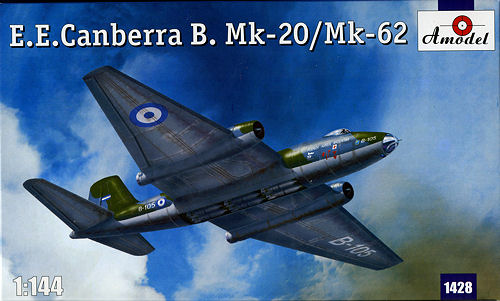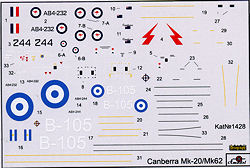
| KIT #: | 1428 |
| PRICE: | $15.00 from www.scale-model-kits.com |
| DECALS: | Three options |
| REVIEWER: | Scott Van Aken |
| NOTES: |

| HISTORY |
The English Electric Canberra is a first-generation jet-powered light bomber manufactured in large numbers through the 1950s. It proved to be highly adaptable, serving in such varied roles for tactical bombing, photographic, electronics, and meteorological reconnaissance. The Canberra remained in service with the Royal Air Force until 23 June 2006, 57 years after its first flight.
The Canberra could fly at a higher altitude than any other bomber through the 1950s and set a world altitude record of 70,310ft (21,430m) in 1957. The type was also used by many other nations, including the US, Argentina, Peru, Australia, and India. In the US two highly modified RB-57s are still in use by NASA, due to their extreme high altitude performance.
| THE KIT |
 Amodel has produced the second injection molded Canberra in 1/144 scale, the first having been done by OzMods. This kit is highly sectional with separate nose, wing section and tail section. This is to allow all the different variations of the type to be built by simply swapping out what is needed. Typical of most 1/144 kits, the cockpit is very basic consisting of little more than a seat, but then, little can be seen in the cockpit of a Canberra anyway. It leaves plenty of room for the inevitable nose weight. The center section has optional bomb bays. One with the door closed and the other with it open an showing a load of six bombs. The plastic is nicely formed without any obvious molding glitches. The clear canopy is quite thick so perhaps it is best that there is little cockpit detail.
Amodel has produced the second injection molded Canberra in 1/144 scale, the first having been done by OzMods. This kit is highly sectional with separate nose, wing section and tail section. This is to allow all the different variations of the type to be built by simply swapping out what is needed. Typical of most 1/144 kits, the cockpit is very basic consisting of little more than a seat, but then, little can be seen in the cockpit of a Canberra anyway. It leaves plenty of room for the inevitable nose weight. The center section has optional bomb bays. One with the door closed and the other with it open an showing a load of six bombs. The plastic is nicely formed without any obvious molding glitches. The clear canopy is quite thick so perhaps it is best that there is little cockpit detail.
The kit can be built with or without the tip tanks, but these were most often seen with them. One exception is the RAAF in Vietnam, where often times, a rack with a bomb was placed under the wing tip. This option is not included in the kit, though two of the three marking options are Australian. However, for those with a bit of talent, a pylon can be made from plastic card and a bomb attached if need be.
 Instructions are well done and use Humbrol paint references. There are markings for three planes. One is
Instructions are well done and use Humbrol paint references. There are markings for three planes. One is  the box art plane (which looks more like a PR.9 than a proper B.62), of the Argentine Air Force. I have to say that the decals for the Argentine roundels have a blue that looks far too dark from what I've seen in photos, but perhaps they were repainted that shade during their long operational life. The scan shows them lighter than they actually are. Something about direct light from a scanner does this. The other two are Australian. One in the high speed silver in which these planes were originally delivered, and the other in a camouflage scheme similar to RAF planes as operated in Vietnam during 1971. I should mention that the camo colors faded quickly in the humid air, producing some rather interesting schemes as shown in the photo. Decals are nicely printed and should provide no real problems in application.
the box art plane (which looks more like a PR.9 than a proper B.62), of the Argentine Air Force. I have to say that the decals for the Argentine roundels have a blue that looks far too dark from what I've seen in photos, but perhaps they were repainted that shade during their long operational life. The scan shows them lighter than they actually are. Something about direct light from a scanner does this. The other two are Australian. One in the high speed silver in which these planes were originally delivered, and the other in a camouflage scheme similar to RAF planes as operated in Vietnam during 1971. I should mention that the camo colors faded quickly in the humid air, producing some rather interesting schemes as shown in the photo. Decals are nicely printed and should provide no real problems in application.
| CONCLUSIONS |
For those who are into 1/144 or want to have a go at a nice kit, this one can be recommended. It will probably take a bit of modeling skill (I've not build an Amodel kit that didn't), but the result will be a very nice display model that won't overwhelm your shelf.
| REFERENCES |
http://en.wikipedia.org/wiki/EE_Canberra
August 2009
Thanks to www.scale-model-kits.com for the preview kit. Get yours today at a discount. If you would like your product reviewed fairly and fairly quickly, please contact the editor or see other details in the Note to Contributors.